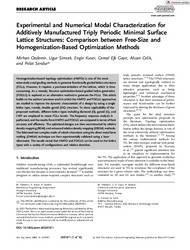Experimental and numerical modal characterization for additively manufactured triply periodic minimal surface lattice structures: Comparison between free-size and homogenization-based optimization methods
| dc.contributor.author | Özdemir, Mirhan | |
| dc.contributor.author | Simsek, U. | |
| dc.contributor.author | Kuşer, Engin | |
| dc.contributor.author | Gayir, C. E. | |
| dc.contributor.author | Celik, A. | |
| dc.contributor.author | Şendur, Polat | |
| dc.date.accessioned | 2023-08-22T13:04:19Z | |
| dc.date.available | 2023-08-22T13:04:19Z | |
| dc.date.issued | 2023-06 | |
| dc.identifier.issn | 1438-1656 | en_US |
| dc.identifier.uri | http://hdl.handle.net/10679/8732 | |
| dc.identifier.uri | https://onlinelibrary.wiley.com/doi/full/10.1002/adem.202201811 | |
| dc.description.abstract | Homogenization-based topology optimization (HMTO) is one of the most extensively used grading methods to generate functionally graded lattice structures (FGLs). However, it requires a precharacterization of the lattices, which is time-consuming. As a remedy, free-size optimization-based graded lattice generation (FOGLG) is explored as an alternative method to generate the FGLs. This article builds on the authors’ previous work in which the HMTO and FOGLG approaches are studied to improve the dynamic characteristic of a design by using a single lattice type, namely, double gyroid (DG) structure. To show applicability of the proposed methods, different lattice types including diamond (D), gyroid (G), and I-WP are employed to create FGLs herein. The frequency response analysis is performed, and the results from HMTO and FOGLG are compared in terms of their accuracy and efficiency. The optimized designs are then reconstructed by relative density mapping (RDM) and enhanced relative density mapping (ERDM) methods. The fabricated test samples made of cobalt–chromium using the direct metal laser melting (DMLM) technique are then experimentally validated using a laser vibrometer. The results reveal that HMTO and FOGLG can be used on the lattice types with a variety of configurations and relative densities. | en_US |
| dc.description.sponsorship | TÜBİTAK | |
| dc.language.iso | eng | en_US |
| dc.publisher | Wiley | en_US |
| dc.relation | info:turkey/grantAgreement/TUBITAK/5158001 | |
| dc.relation.ispartof | Advanced Engineering Materials | |
| dc.rights | Attribution-NonCommercial-NoDerivatives 4.0 International | |
| dc.rights | openAccess | |
| dc.rights.uri | https://creativecommons.org/licenses/by-nc-nd/4.0/ | |
| dc.title | Experimental and numerical modal characterization for additively manufactured triply periodic minimal surface lattice structures: Comparison between free-size and homogenization-based optimization methods | en_US |
| dc.type | Article | en_US |
| dc.peerreviewed | yes | en_US |
| dc.publicationstatus | Published | en_US |
| dc.contributor.department | Özyeğin University | |
| dc.contributor.authorID | (ORCID 0000-0003-2212-7419 & YÖK ID 274138) Şendur, Polat | |
| dc.contributor.ozuauthor | Şendur, Polat | |
| dc.identifier.volume | 25 | en_US |
| dc.identifier.issue | 11 | en_US |
| dc.identifier.wos | WOS:000950926300001 | |
| dc.identifier.doi | 10.1002/adem.202201811 | en_US |
| dc.subject.keywords | Free-size optimization | en_US |
| dc.subject.keywords | Functionally graded lattices | en_US |
| dc.subject.keywords | Homogenization | en_US |
| dc.subject.keywords | Topology optimization | en_US |
| dc.subject.keywords | Triply periodic minimal surface (TPMS) | en_US |
| dc.identifier.scopus | SCOPUS:2-s2.0-85150449522 | |
| dc.contributor.ozugradstudent | Özdemir, Mirhan | |
| dc.contributor.ozugradstudent | Kuşer, Engin | |
| dc.relation.publicationcategory | Article - International Refereed Journal - Institutional Academic Staff, Graduate Student and Undergraduate Student |
Files in this item
This item appears in the following Collection(s)
Share this page




